When it comes to getting the most juice out of your solar panels, there’s one golden rule: face the equator. If you’re in the Northern Hemisphere (think the U.S. or Europe), your panels should be aimed verdadero sur. For those down under in the Southern Hemisphere (like Australia or South America), you’ll want to point them true north.
It's a simple concept, but it's the foundation of a high-performing solar setup.
Why Panel Direction Is A Game Changer

Think of your solar panels like a sunbather trying to get the perfect tan. You wouldn't face away from the sun, right? The same logic applies here. To capture the maximum amount of energy, your panels need to be pointed where the sun spends most of its time in the sky.
This single factor—your panel's orientation—has the biggest impact on how much power your system generates throughout the day. Getting this right is what separates a decent solar investment from an incredible one.
Even small deviations can make a difference. Veering just 15 grados east or west of the ideal direction can cut your total energy production by 5-10% over the year. That's a noticeable dip in your savings.
How Panel Direction Impacts Annual Energy Output
Let's break down what this looks like in the real world for someone in the Northern Hemisphere. We'll use a south-facing roof as the 100% benchmark, but you'll see that other directions can still be very productive.
Annual Energy Output by Panel Direction (Northern Hemisphere)
graph TD
subgraph Legend
A[100% - South] --> B(95% - SE/SW)
B --> C(85% - East/West)
C --> D(70% - North)
end
subgraph Chart
direction LR
South(South) -- 100% --> SE_SW(SE / SW)
SE_SW -- 90-95% --> East_West(East / West)
East_West -- 80-85% --> North(North)
end
style A fill:#4CAF50,color:#fff
style B fill:#8BC34A,color:#fff
style C fill:#FFC107,color:#000
style D fill:#F44336,color:#fff
| Panel Direction | Relative Annual Energy Output | Lo mejor para |
|---|---|---|
| True South | 100% | Maximizing total yearly energy production and savings. |
| Southeast / Southwest | ~90-95% | Excellent alternatives with minimal energy loss. |
| East / West | ~80-85% | Capturing morning or afternoon sun, useful for specific energy usage patterns. |
| True North | ~65-70% | Generally avoided unless it's the only unshaded option available. |
As you can see, even if your roof doesn't face perfectly south, an east or west-facing installation is still a fantastic option, capturing a huge chunk of available sunlight.
The goal is to align your panels as perpendicular to the sun’s path as possible. This positioning ensures they absorb the maximum amount of solar radiation, directly boosting your home's energy independence and reducing utility bills.
If you're building a new home, you have a unique advantage. You can incorporate solar orientation from the very beginning. Checking out eco-friendly house plans can show you just how seamlessly solar can be integrated into a modern, efficient design.
Ultimately, it all starts with this one rule: face the equator. It’s the first and most critical step toward unlocking your home's solar potential.
Why Panel Direction Is a Game Changer for Energy Output

We've established that facing the equator is the golden rule for solar panels, but let's get into why this simple adjustment makes such a massive difference. It all comes down to a concept from physics called the angle of incidence. This is just a technical way of describing the angle at which sunlight actually hits the surface of your solar panels.
Think about it like this: if someone tossed you a baseball, you'd want to be right in front of it to catch it cleanly. If it comes at you from a weird side angle, you're more likely to fumble it. Solar panels are the same way with sunlight. They "catch" the most energy when the sun’s rays strike them head-on, at a perfect 90-degree angle.
When that light comes in at a shallow angle, however, a lot of its energy essentially glances off the surface. This means less power is absorbed, and your system’s output drops. The best direction is always the one that keeps the sun as perpendicular to your panels as possible for the longest part of the day.
Azimuth and Tilt: Your Solar Power Dials
To hit that energy-producing sweet spot, installers fine-tune two critical settings: azimut y inclinación. These two adjustments work hand-in-hand to point your panels directly into the sun’s most productive path across the sky, often called the “solar window.”
- Azimuth is simply the compass direction your panels are facing. Like we've covered, this is almost always true south if you're in the Northern Hemisphere and true north if you're in the Southern Hemisphere.
- Tilt refers to the vertical angle of the panels in relation to the flat ground. This angle is tweaked to account for how high or low the sun sits in the sky, which changes depending on the season and how far you are from the equator.
Nailing the azimuth is the first and most important step. Around the world, this one factor can cause huge swings in how much power a system generates. In fact, getting the azimuth wrong can slash your potential energy production by up to 15-20%—a major loss for any solar investment.
Simply put, a well-aligned panel works smarter, not harder. By optimizing its position to face the sun directly, you ensure that every square inch of your investment is generating as much clean power as possible.
This level of precision is what separates a good solar system from a great one. For homeowners trying to get the most savings out of their panels, understanding these basics is crucial. Digging into the details of system alignment is a core part of effective optimización de paneles solares and can make a huge difference in your long-term return. The chart below shows just how dramatic the difference can be.
Impact of Azimuth Angle on Solar Panel Output
xychart-beta
title "Solar Output vs. Azimuth Angle (Relative to True South)"
x-axis "Degrees from True South (Azimuth)" [-90, -45, 0, 45, 90]
y-axis "Relative Energy Output (%)" [70, 105]
bar [90, 97, 100, 97, 90]
Finding the Perfect Tilt Angle for Your Location

Once you've pointed your panels in the right direction, it's time to dial in the tilt. If direction gets you in the right ballpark, think of the tilt angle as picking the best seat in the house. This is the fine-tuning that ensures your panels are perfectly positioned to soak up the maximum amount of sunlight throughout the year.
This vertical angle is a big deal because the sun’s height in the sky changes so dramatically between seasons. In the summer, the sun is high overhead, so a flatter, lower tilt works best. But in the winter, the sun hangs low on the horizon, which means a steeper angle is needed to catch those rays head-on.
The Latitude Rule of Thumb
A fantastic and surprisingly simple starting point is to just use your home’s latitude as your tilt angle. For example, if you live in Denver, Colorado, which sits at a latitude of roughly 40 degrees, setting your panels to a 40-degree tilt is a great baseline for year-round energy production.
For most people, that simple rule is more than good enough. But if you want to get a little more specific without the hassle of adjusting your panels twice a year, you can make a couple of tweaks.
- To maximize winter sun: Añadir 15 grados to your latitude. So, at 40 degrees latitude, you’d set your panels to 55 degrees. This is perfect if your energy usage spikes in the colder, darker months.
- To maximize summer sun: Resta 15 grados from your latitude. For that same home, you’d use a 25-degree tilt. This is a great strategy if your biggest energy hog is your air conditioner.
For a fixed-tilt system, the name of the game is finding the best compromise. While you can squeeze out a tiny bit more power with seasonal adjustments, most homeowners get the best value from a single, optimized angle that performs well all year long.
This chart from the Argonne National Laboratory really brings this concept to life.

As you can see, the farther you get from the equator (as latitude increases), the steeper the ideal tilt angle becomes. This adjustment helps the panels face the sun more directly as its average position in the sky gets lower. Following these guidelines is a crucial step in making sure your solar investment is working as hard as it possibly can for you.
How Geography and Climate Influence Your Best Direction
The golden rule of facing the equator is a fantastic starting point, but the real world always throws in a few curveballs. While a south-facing array (if you're in the Northern Hemisphere) gives you the best year-round average, your local geography and climate can present opportunities to tweak that strategy for even better results.
Think of it this way: the sun might be highest in the southern sky, but if it’s consistently hiding behind clouds for half the day, that "perfect" orientation loses some of its punch. Local weather patterns are a huge variable that can nudge the best direction for solar panels away from the textbook answer.
Adapting to Your Local Climate
Let's take a real-world example. Imagine a home in a coastal California city where a thick morning fog is a daily ritual. That fog often doesn't burn off until noon, but when it does, you get a blast of powerful afternoon sun. In a situation like this, pointing the panels slightly southwest is a smart, strategic move. You're intentionally sacrificing some of that weaker morning light to capture the maximum amount of energy during the clear, intense afternoon hours.
On the flip side, someone living in Florida, where afternoon thunderstorms are practically a daily summer appointment, might get more from an east-facing array. This setup would front-load energy generation into the clear, sunny mornings before the clouds inevitably roll in, matching production to the day's most reliable sunlight.
Your local climate creates a unique solar "schedule." The most effective solar panel direction isn't just about where the sun is, but cuando it's most accessible to your panels.
Time and again, real-world data from top solar markets shows that panels facing the equator outperform other orientations by 10-20% annually. For example, a detailed study of installations in Japan found that south-facing panels generated about 15% more electricity over a year compared to west-facing ones. That's a significant boost to your return on investment.
This data confirms the baseline is solid, but paying attention to local conditions is how you squeeze every last drop of value from your system. This becomes even more important as the seasons change. We dive deeper into how things like snow impact production in our guide on if solar panels will work in winter.
The Overlooked Factor: Shading
Even more critical than regional climate is the immediate geography of your own property. Persistent shade from trees, a chimney, or your neighbor's new second-story addition can completely sabotage an otherwise perfectly oriented system. A completely unshaded east-facing roof will always outperform a south-facing one that’s stuck in a tree's shadow for hours every day.
This is where a proper site assessment becomes non-negotiable.

As you can see, everyday obstructions can lead to serious energy loss. The good news is that modern technology, particularly the use of microinverters, can help recover a good chunk of that lost potential by isolating the shaded panels from the rest of the system.
What If South-Facing Isn't an Option?
So, what happens if your roof isn't a perfect, south-facing canvas? Don't sweat it. This is a common situation, and it’s far from a dealbreaker. In fact, deliberately choosing an east or west-facing orientation can be a savvy move, especially when you think about cómo y cuando your family actually uses electricity.
It's easy to get fixated on south-facing systems as the ultimate goal for total annual production. But sometimes, the smartest play isn't about generating the absolute most power over a year—it's about generating power at the most expensive times of the day.
Syncing Your Solar With Your Life
Think of an east-west system as a way to customize your power plant. You can time your energy generation to line up perfectly with your daily routine.
- East-Facing Panels: These are your morning workhorses. They jump into action as the sun comes up, cranking out power right when you need it most for the morning rush—brewing coffee, running the toaster, and getting everyone ready for the day.
- West-Facing Panels: These are the afternoon heroes. Their production ramps up later in the day, hitting its stride just as the kids get home from school, the air conditioning kicks on, and you start prepping for dinner.
The goal shifts from simply making the most energy to making energy when it matters most to you.
The Time-of-Use Rate Game-Changer
This strategy becomes incredibly valuable if your utility company uses Time-of-Use (TOU) rates. Under a TOU plan, the price of electricity skyrockets during "peak hours," which are usually in the late afternoon and early evening when everyone is getting home and turning things on.
A west-facing system can often save you more money than a south-facing one—even if it produces less total energy—simply by generating power during those high-cost peak hours.
Solar Production vs. Peak TOU Rates
gantt
title Solar Generation & TOU Rate Alignment
dateFormat HH
axisFormat %H:00
section East-Facing
Production :06, 6
section West-Facing
Production :12, 6
section Typical TOU Peak
Peak Rates :16, 5
Let's break down how that works:
| System Direction | Peak Production Time | Alignment with TOU Rates | Potential Savings Impact |
|---|---|---|---|
| East-Facing | Morning (7 AM – 12 PM) | Generates power during cheaper off-peak morning hours. | Good for covering morning energy use. |
| West-Facing | Afternoon (2 PM – 7 PM) | Generates significant power during expensive peak hours. | Excellent for wiping out the highest-cost electricity bills. |
When your panels are producing their own free power right when grid electricity is most expensive, you amplify the value of every single kilowatt-hour. This can make a west-facing array an incredibly smart financial decision for anyone trying to beat those brutal afternoon energy prices.
Finding Your Perfect Setup with Modern Tools
So, how do you take all this theory and apply it to your actual roof? While you could pull out a compass, professionals have much more accurate ways to nail the perfect placement and find the best direction for solar panels for your unique home.
One little detail that trips people up is the difference between magnetic north (what a compass points to) and true north, which is the geographic North Pole. All solar calculations rely on true north, so getting this right is key for the azimuth. The good news? Modern tools automatically account for this.
Digital Modeling for Your Home
You don't need an engineering degree to get a surprisingly accurate preview of your home's solar power potential. A few fantastic online resources can give you a solid performance estimate before you even talk to an installer.
- NREL's PVWatts® Calculator: This is the industry benchmark. It's a free tool from the National Renewable Energy Laboratory that lets you plug in your address, roof direction, and tilt angle to get a detailed forecast of your monthly and annual energy output.
- Google Project Sunroof: Using Google Maps data, this tool analyzes your roof for solar potential, even considering local weather and shading from trees or nearby buildings.
Playing around with these tools gives you a fantastic baseline. You can see for yourself how a west-facing array stacks up against a south-facing one on your property. To see how that energy output translates into the number of panels you'd need, a good solar system sizing calculator can help connect the dots.
A professional assessment takes this a step further. Installers use specialized software to create a 3D model of your property and run a full shade analysis, tracking the sun’s exact path across your roof all year to pinpoint any energy-sapping obstructions.
Why a Professional Site Assessment Matters
Online tools are brilliant for getting started, but they can't beat a pair of expert eyes on your property. Nothing replaces a proper on-site evaluation.
A professional installer will use a tool like a Solar Pathfinder to get a precise, real-world measurement of your roof's "solar window." This hands-on analysis catches shading issues that satellite images might miss, like that big oak tree, your chimney, or even a neighbor's planned second-story addition. This detailed report gives you the confidence to know your final system design is truly built for the best possible return on your investment.
Common Questions About Solar Panel Direction
As you get closer to finalizing your solar plans, a few key questions always seem to pop up. Nailing down these last few details is what gives you the confidence to move forward, knowing you've found the best direction for your solar panels.
Let's dive into some of the most common things people ask.
What If My Roof Faces Southeast or Southwest?
This is a great question, and the answer is simple: don't worry about it. These are still fantastic directions for a solar array.
While a roof facing true south is the technical ideal, delivering 100% of potential output, a southeast or southwest orientation is barely a step down. You can still expect to generate about 90-95% of the maximum, which is a tiny difference in the grand scheme of your energy savings.
The energy loss is so small that these systems still deliver incredible savings and a powerful return on your investment. We can even use tools like the PVWatts calculator to model your exact roof and show you precisely what to expect.
A slight deviation from "perfect" south is far less important than having clear, unobstructed sunlight. At the end of the day, a high-performing system is one that simply gets the most sun.
Should I Adjust My Panel Angle Every Season?
The short answer is no, it's almost never worth the hassle for a homeowner. While you can technically squeeze out a few extra percentage points of energy by tilting your panels for winter and summer, the vast majority of residential systems use a fixed-tilt mount for very good reasons.
Fixed systems are the gold standard because they are:
- Mechanically simpler with fewer things that can go wrong.
- More durable and built to withstand the elements for decades.
- Maintenance-free, with no moving parts to worry about.
Your installer will set your panels at the optimal angle for year-round performance, giving you the best balance of peak production and long-term reliability.
How Much Does Shade Impact My Panel Direction?
Shade is the number one enemy of solar production. It’s a much, much bigger deal than getting the compass direction perfect.
Think of it this way: a completely unshaded, east-facing roof will always outperform a south-facing roof that’s covered by a tree's shadow for three hours every afternoon. No contest.
Even a little bit of shade on a single panel can dramatically reduce the output of the entire string of panels it's connected to. This is why technologies like microinverters are so game-changing. They let each panel work on its own, so if one panel gets a little shade, it won't drag the rest of the system down with it.
Ready to get a professional take on your roof's unique solar potential? The experts at Energía radiante can perform a detailed site analysis to design a system that maximizes your energy production and savings. Learn more and get your free quote today.




